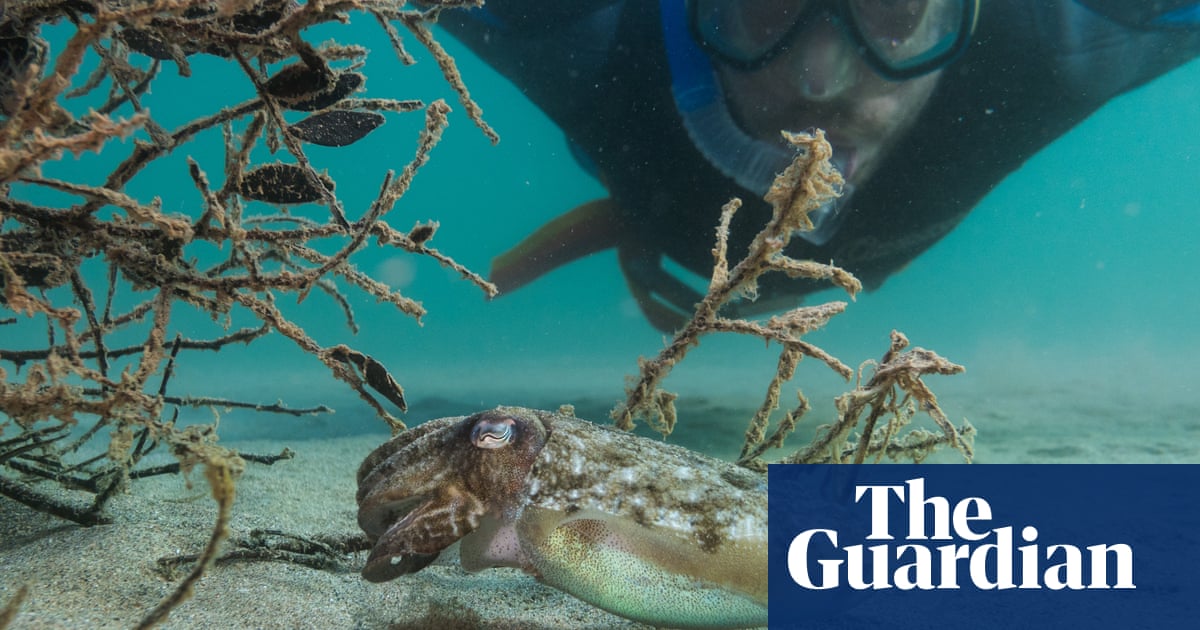Clinging to almost vertical cliffs on the Costa Brava in north-east Spain, the resort of lâEstartit has a dramatic location but the real drama is unfolding under the waves, where an innovative approach to ancient techniques is helping to revive declining populations of prized cuttlefish
Cuttlefish (Sepia officinalis) are a valuable catch for Spanish fishers and a popular dish, either on their own or as a key ingredient in seafood paella. However, their numbers have declined on the Catalan coast through a combination of pollution and unregulated recreational fishing.
In 2017, a fortuitous meeting between a local fisherman, Isaac Moya, and a marine biologist, Boris Weitzmann, led to the creation of the Sepia Project, which has the twin objective of reviving stocks and keeping artisanal fishers in business.
The project fixes tree branches to the shallow sea bed just beyond the Estartit harbour wall, as cuttlefish need somewhere solid to lay their eggs.
âFishers have been putting branches on the sea bed to attract cuttlefish for thousands of years,â says Weitzmann. âIn Morocco they use palms; in Galicia, pines. Using this traditional method we attached different species of tree branches to ropes. Itâs a case of looking to the past in order to move forward.â
However, not content with waiting for the molluscs to lay their eggs, the project uses the underwater branches as incubators for eggs that attach to fishing nets.
Moya set out to persuade others in his fishing comunity to save the eggs in buckets of water rather than throw them into the sea where they perish. The buckets are then left on the quayside and the eggs are distributed among the branches that serve as a nursery.
Although he is well known locally, Moya does not come from a fishing family and at first had a hard time persuading others not to throw the eggs away.
âTheir attitude was a bit âwhat do you know?â,â he says, but fortunately several young locals were open to new ideas. In the first two years of the project they collected 1.5m eggs.
âItâs important that Isaac doesnât come from a family of fishers,â Weitzmann says. âIn the history of humanity, innovation doesnât come from within, it comes from outside. What we have done here is combine tradition and innovation to achieve a transformation.â
The project is not just about conservation. It also aims to keep artisanal fishers in business by helping them to sell their catch at a fair price. âItâs a perfect example of the circular economy,â he says.
They have chosen cuttlefish partly because they have a short life cycle. They lay their eggs in spring and after six to eight weeks the project takes the young to grow in the open sea. They reach maturity within a year, giving the fishers a good catch after the lean winter months.
âCuttlefish often die after theyâve laid their eggs,â Weitzmann says. âThey have inbuilt planned obsolescence.â In effect, catching a mature cuttlefish once it has laid its eggs has little impact on the population.
The project looked for support from bodies such as the nearby Montgrà national park but also from local businesses, ranging from car mechanics to a three-star Michelin restaurant, El Celler de Can Roca.
âWe wanted everyone to have a stake in it,â Weitzmann says. âWe could have got more money from the European Union but what happens is you get the money to run a project for two years then they file it away in a drawer and thatâs that.
âWeâre producing more cuttlefish but thatâs not really the point,â he says. âWe want to change the mentality of both fishers and consumers.
âConsumers need to be educated about what theyâre buying and where their money is going. Most people donât ask or care.
âAs a fisherman, if I need â¬500 [£415]a month to cover my expenses and Iâm paid â¬5 for a fish thatâs worth â¬10, I have to catch twice as many fish,â says Moya. âThe consumer is the primary cause of overfishing.â
It is illegal in Spain for fishers to sell directly to the public. They have to go through the local association and then the wholesalers.
âThe system is based on a reverse auction, which pushes down prices and we artisanal fishers canât compete with industrial boats,â says Moya. âThey arrive with 500kg of cuttlefish and the price is set; we arrive with 10kg and no one is interested.â
To combat this, a handful of fishers from lâEstartit and nearby lâEscala have set up Empescaât, an organisation that aims to sell directly to local people and businesses, although Moya says neither the fisheries sector nor the regional government has encouraged them.
Despite many setbacks, Covid among them, both Moya and Weitzmann remain optimistic.
âItâs like fruit, you have to wait but eventually it ripens and falls,â Weitzmann says. âAnd besides, everyone knows that if we carry on the way we are, thereâs no future.â



